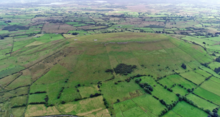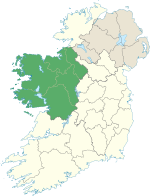Knocknashee
| Knocknashee | |
|---|---|
| Cnoc na Sí | |
 | |
| Highest point | |
| Elevation | 276 m (906 ft)[1] |
| Prominence | 171 m (561 ft) |
| Listing | Marilyn |
| Coordinates | 54°07′12″N 8°40′47″W / 54.119991°N 8.679780°W |
| Naming | |
| English translation | Hill of fairies |
| Language of name | Irish |
| Geography | |
| Parent range | Ox Mountains |
| OSI/OSNI grid | G556192 |

Knocknashee (Cnoc na Sí in Irish) is a 276-metre (906 ft) Marilyn in the Ox Mountains, County Sligo, Ireland.
Geography
The River Moy rises at the foot of Knocknashee.
Geology
Knocknashee hill consists of a limestone top with shales underlying the lower slopes.[2]
Archaeology
Knocknashee was identified as a hilltop fort in 1988. It is an enclosed hill fort with limestone ramparts containing cairns, burial chambers and hutsites. The fort is 700 metres long and 320 metres wide and is enclosed by two earth and stone ramparts covering an area of 53 acres. The site was discovered during an aerial survey of county Sligo by the Office of Public Works in 1988.
Name
The name of the plateau itself comes from Irish, ‘knock’ (cnoc) meaning ‘hill’ and ‘shee’ (sí) meaning ‘burial mound’ or 'of the fairies'. In older Irish Knocknashee is known as Mullinabreena.
Popular culture references
"Knocknashee" was a play by Irish playwright Deirdre Kinahan. It was first produced 24 January 2002 in the Civic Theatre, Tallaght, Dublin 24.[3]
"The Hills Of Knocknashee" is a traditional Irish song. The River Moy so gently flows from there unto the sea. Farewell to you, farewell to all from the hill of Knocknashee [4]
"Knocknashee" with music by Neil Martin and lyrics by Brendan Graham [5]
References
- ^ Mountain Views http://mountainviews.ie/mv/index.php
- ^ GSI Knocknashee Hill http://www.gsi.ie/Education/Sites_Walks_Field+Trips/Knocknashee+Hill.htm
- ^ Irish playography "Knocknashee" http://www.irishplayography.com/search/play.aspx?la=en&play_id=235[permanent dead link]
- ^ "The Hills Of Knocknashee" lyrics and chords http://www.martindardis.com/id818.html
- ^ "Knocknashee" lyrics http://www.anthonykearns.net/KnocknasheeLyrics.html Archived 2010-08-12 at the Wayback Machine


